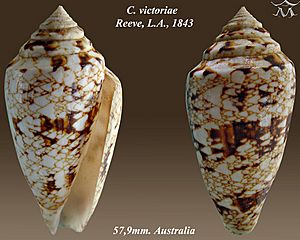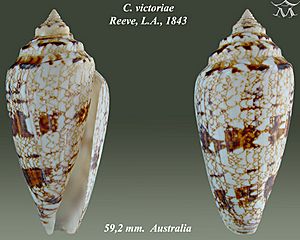Conus victoriae facts for kids
Quick facts for kids Conus victoriae |
|
|---|---|
 |
|
| Apertural and abapertural views of shell of Conus victoriae Reeve, L.A., 1843 | |
 |
|
| Scientific classification | |
| Synonyms | |
|
The Conus victoriae, commonly called the Queen Victoria cone, is a type of sea snail. It is a marine gastropod mollusk that belongs to the family Conidae. This family includes all the cone snails and their relatives.
Just like other Conus snails, the Queen Victoria cone is a predator. It is also venomous. These snails can "sting" humans. Because of this, it is very important to be careful with them. It is best not to touch live ones at all.
Contents
About the Queen Victoria Cone
What Does It Look Like?
The shell of the Queen Victoria cone can be anywhere from about 35 millimeters (1.4 inches) to 94 millimeters (3.7 inches) long. This snail eats other mollusks.
It looks a bit like another snail called Conus textile. However, the Queen Victoria cone has different patterns. Its patterns are usually smaller and lighter in color. These light patterns stand out against very dark, chocolate-colored stripes. The shell also often has purple-blue cloudy areas.
Where Does It Live?
This sea snail lives only in Australia. You can find it in Western Australia, from Broome north. It also lives in the Northern Territory, near the mouth of the Victoria River. This is where it was first found in 1843.
How Scientists Study This Snail
Scientists have learned a lot about the Queen Victoria cone. They study how its venom works. They also look at how its venom-making parts develop.
One part of its venom, called alpha conotoxin Vc1.1, is very interesting. Studies show it can help with pain in animals. Scientists are looking into whether it could be used as a medicine for pain in humans. It might even be a replacement for strong pain medicines like morphine.
Gallery





